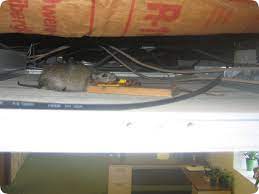Discovering mice in your ceiling can be a distressing experience for any homeowner. The incessant scratching, scurrying, and gnawing noises they make can keep you up at night, not to mention the potential health hazards they pose. In this article, we’ll explore the various steps you can take to address a mouse infestation in your ceiling, from identifying the problem to effectively eliminating these unwanted guests.

Identifying the Signs of a Mouse Infestation
Before you can address the issue of mice in your ceiling, it’s important to confirm their presence. Here are some common signs that may indicate a mouse infestation:
- Audible Noises: Mice are nocturnal creatures, so you may hear them making scratching or squeaking sounds in the ceiling during the night.
- Droppings: Mice leave behind small, pellet-like droppings. These can often be found near their nesting areas or along their travel paths.
- Gnaw Marks: Mice have a constant need to gnaw on things to keep their teeth from overgrowing. Look for chewed wires, insulation, or other materials in your ceiling.
- Nesting Materials: If you find materials like shredded paper, fabric, or insulation in your ceiling, it’s likely that mice are nesting there.
Steps to Address Mice in Ceiling
Once you’ve identified the signs of a mouse infestation in your ceiling, it’s essential to take prompt action. Here’s what you can do:
- Seal Entry Points: Mice can enter your home through tiny gaps and holes. Inspect the exterior of your house for any openings and seal them with steel wool or caulk. Focus on areas around pipes, vents, and cables that lead into your ceiling.
- Set Traps: Traps are an effective way to catch mice in your ceiling. You can use snap traps, glue traps, or humane live traps, depending on your preference. Place traps in areas where you’ve noticed mouse activity, like near the sounds or droppings.
- Use Bait Stations: Bait stations are another option for trapping mice. These stations contain poison baits that can eliminate the mice, but they should be used with caution, especially if you have pets or children.
- Monitor and Remove Trapped Mice: Check your traps or bait stations daily, and remove any trapped mice promptly to prevent odors and further infestation. Be sure to wear gloves and dispose of the mice properly.
- Professional Pest Control: If the infestation is severe or persists despite your efforts, it’s advisable to seek the assistance of professional pest control services. They have the expertise and tools to address more complex infestations.
Read too: How Expensive Are Floor To Ceiling Windows
Preventing Future Mouse Infestations
To ensure that mice do not return to your ceiling, consider these preventive measures:
- Maintain Cleanliness: Keep your home clean and free of food debris. Store food in airtight containers, and clean up crumbs and spills promptly.
- Secure Trash: Make sure your trash cans have tight-fitting lids and empty them regularly.
- Trim Trees and Bushes: Keep branches and vegetation near your home trimmed to eliminate potential entry points for mice.
- Inspect Your Home Regularly: Periodically inspect your home for any potential entry points and seal them to prevent mice from getting in.
- Use Peppermint Oil: Mice are known to dislike the smell of peppermint. Placing cotton balls soaked in peppermint oil in your ceiling or around your home may deter them from nesting there.
Conclusion
Mice in your ceiling can be a nuisance and a health hazard. Identifying the signs of an infestation and taking swift action is crucial to address the problem effectively. Use traps, bait stations, or professional pest control services as needed to eliminate the mice, and take preventive measures to ensure they don’t return. With persistence and vigilance, you can regain control of your home and enjoy a mouse-free living space.